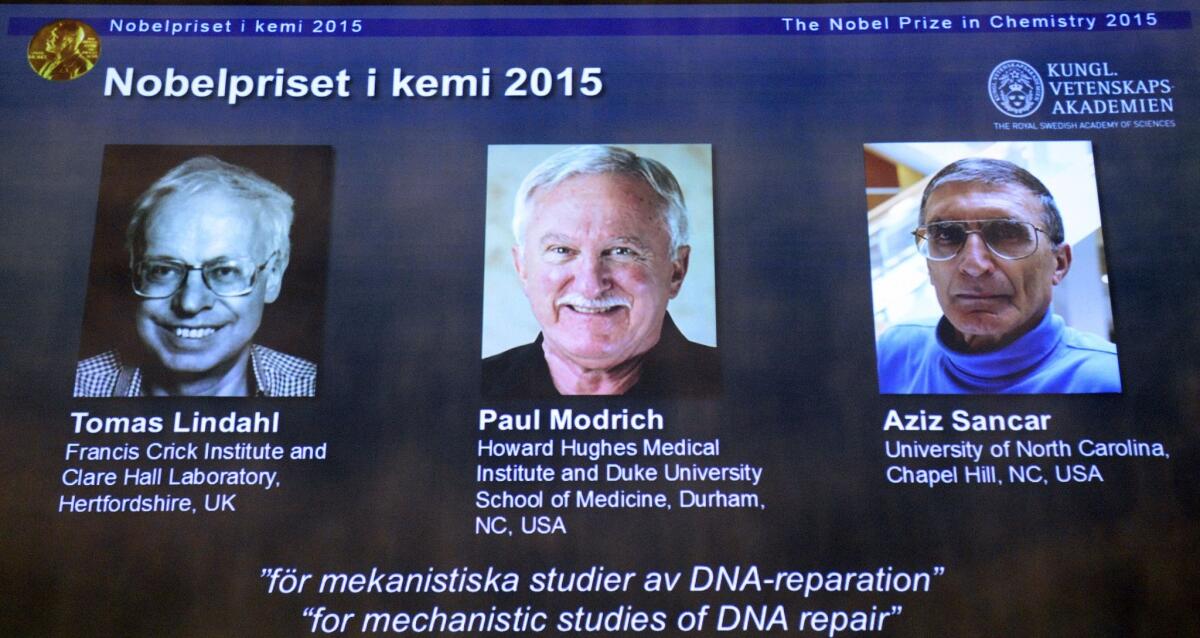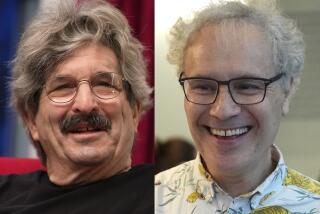Three researchers win Nobel Prize in chemistry for studies of DNA repair

Tomas Lindahl, Paul Modrich and Aziz Sancar have earned the 2015 Nobel Prize in chemistry for their studies of DNA repair.
- Share via
The 2015 Nobel Prize in chemistry has been awarded to Tomas Lindahl, Paul Modrich and Aziz Sancar for pioneering work on the fragile, unstable DNA molecule, revealing the lengths to which the cell must go to repair it.
Their investigations into the chemistry underlying some of these mechanisms have provided insight into a wide spectrum of diseases, including cancer.
“This basic understanding about cell function has led to the discovery of the causes of genetic conditions associated with cancer, and is being used to develop new cancer treatments,” Dr. Francis Collins, director of the National Institutes of Health, said in a statement.
The findings also have revealed how vital an understanding of basic chemistry is to improving human health, said Diane Grob Schmidt, president of the American Chemical Society. “It highlights the importance of chemistry in a biological context,” she said in an interview.
See the most-read stories this hour >>
Lindahl, of the Francis Crick Institute and Clare Hall Laboratory in England, said he was caught off guard when he was called Wednesday morning. “It was a surprise.... I feel very lucky and proud to be selected today,” Lindahl said via telephone during a briefing announcing the three laureates.
Deoxyribonucleic acid, or DNA, is the molecule that holds the instructions for building and operating our bodies. Using four bases — adenine, guanine, thymine and cytosine — this double-stranded helix codes the information for the proteins that serve as builders and bricks for the cells in our bodies.
------------
FOR THE RECORD
Oct. 8, 10:46 p.m.: An earlier version of this article described the building blocks of DNA — adenine, guanine, thymine and cytosine — as nucleotides. They are nucleic acid bases, and they combine with sugar and phosphoric acid to form nucleotides.
------------
Humans have a lot of DNA, which means there is a lot of opportunity for error, scientists said. And yet, the DNA from each of those cells, in spite of all the potential for damage and copying mistakes, remains remarkably similar on the whole.
Mutations do occur in DNA, and a few mutations every so often are actually a good thing — it’s essentially what powers evolution. But on the whole, scientists had long assumed that DNA was inherently stable.
Lindahl’s work showed otherwise, revealing that there were probably thousands of terrible injuries to the genome on any given day. Our genetic code, it seemed, was constantly falling apart, unable to withstand its own native environment.
“I was studying the properties of DNA and found, somewhat to my surprise, that DNA is much more labile than we usually recognize,” Lindahl said. “It gets damaged in cells by the water we live in, and that cannot be avoided, so that means you have to repair DNA all the time.”
Lindahl began looking for signs of any enzymes that were tasked with these repairs. He discovered that molecular machinery in the cell is hard at work constantly fixing the damage suffered by the delicate DNA molecule. This mechanism, called base excision repair, is able to identify mistakes in the code, pull out the offending piece and replace it with the proper one.
“We can’t avoid DNA damage. We live in a world where we get exposed to DNA-damaging agents all the time, and many of those are in our cells and we can’t avoid them,” Lindahl said.
Modrich, of the Howard Hughes Medical Institute and Duke University, looked at another tool in the body’s toolbox: the mechanism that fixes flubs that happen when DNA is copied during cell division. This molecular system identifies which strand is the original and which one is the copy, and then fixes the mistake in the copy. Called mismatch repair, this process cuts the frequency of these kinds of errors by roughly a thousandfold.
Sancar, of the University of North Carolina at Chapel Hill, discovered nucleotide excision repair, the tool that bodies use to fix damage caused by ultraviolet radiation. UV radiation can damage DNA, and without a functioning mechanism to repair that damage, it can eventually lead to skin cancer.
“The important work of Lindahl, Modrich and Sancar has provided an answer to one part of this puzzle — how DNA repairs itself when damaged, every day, through processes within each cell,” Mark Downs, chief executive of Britain’s Royal Society of Biology, said in a statement. “Without these mechanisms we would probably not exist and would certainly all die young.”
The scientists will share a prize of 8 million Swedish kronor, or close to $1 million.
For more science news, follow @aminawrite on Twitter and “like” Los Angeles Times Science & Health on Facebook.
ALSO
New tool can identify soldiers most likely to commit violent crimes, study shows
BLM decision sets back Cadiz plan to sell Mojave groundwater
Near the site of the Chernobyl nuclear disaster, wildlife bounces back







